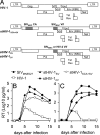A macaque model of HIV-1 infection
- PMID: 19255423
- PMCID: PMC2657417
- DOI: 10.1073/pnas.0812587106
A macaque model of HIV-1 infection
Abstract
The lack of a primate model that utilizes HIV-1 as the challenge virus is an impediment to AIDS research; existing models generally employ simian viruses that are divergent from HIV-1, reducing their usefulness in preclinical investigations. Based on an understanding of species-specific variation in primate TRIM5 and APOBEC3 antiretroviral genes, we constructed simian-tropic (st)HIV-1 strains that differ from HIV-1 only in the vif gene. We demonstrate that such minimally modified stHIV-1 strains are capable of high levels of replication in vitro in pig-tailed macaque (Macaca nemestrina) lymphocytes. Importantly, infection of pig-tailed macaques with stHIV-1 results in acute viremia, approaching the levels observed in HIV-1-infected humans, and an ensuing persistent infection for several months. stHIV-1 replication was controlled thereafter, at least in part, by CD8+ T cells. We demonstrate the potential utility of this HIV-1-based animal model in a chemoprophylaxis experiment, by showing that a commonly used HIV-1 therapeutic regimen can provide apparently sterilizing protection from infection following a rigorous high-dose stHIV-1 challenge.
Conflict of interest statement
The authors declare no conflict of interest.
Figures





References
-
- Ambrose Z, KewalRamani VN, Bieniasz PD, Hatziioannou T. HIV/AIDS: in search of an animal model. Trends Biotechnol. 2007;25:333–337. - PubMed
-
- Fultz PN. Nonhuman primate models for AIDS. Clin Infect Dis. 1993;17(Suppl 1):S230–S235. - PubMed
-
- Daniel MD, et al. Isolation of T-cell tropic HTLV-III-like retrovirus from macaques. Science. 1985;228:1201–1204. - PubMed
-
- Harouse JM, Gettie A, Tan RC, Blanchard J, Cheng-Mayer C. Distinct pathogenic sequela in rhesus macaques infected with CCR5 or CXCR4 utilizing SHIVs. Science. 1999;284:816–819. - PubMed
Publication types
MeSH terms
Substances
Grants and funding
LinkOut - more resources
Full Text Sources
Other Literature Sources
Medical
Research Materials

